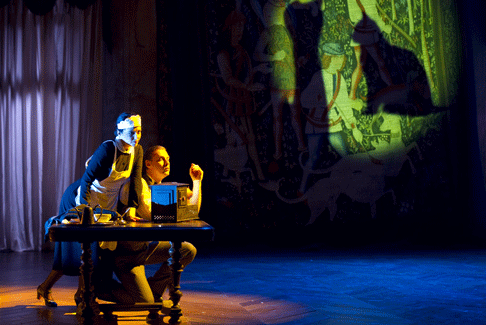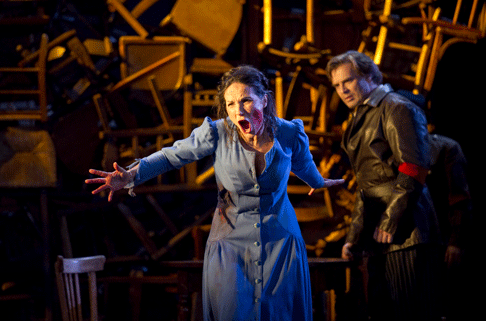Even without this automotive hardware Monaco may still have been magical eighty-seven years ago when Maurice Ravel and Colette conjured a strange little comÈdie musicale, L’Enfant et les Sortileges for this very opera house. These days Colette’s singing cats, clocks, teakettles, etc., only sometimes recapture the magic that is said have surprised, puzzled and perturbed the monÈgasques (those rich enough to sojourn in Monaco) back in 1925.
Happily all of L’Enfant’s reputed magic was again present in the Salle Garnier, brought alive by Monaco’s fine Orchestre Philharmonique responding to the remarkable precision of narrative detail and intonation imposed by conductor Patrick Davin. Ravel’s score shone as the masterpiece of orchestral colors and musical wit that has won it huge respect and exposure in musical circles.
If you are among those who find people impersonating animals, objects or elements (there is a big piece for a soprano named “fire”) amusing this fine new production by the OpÈra de Monte-Carlo’s general director Jean-Louis Grinda might have disappointed you. As it was we were not required to suspend disbelief for a second. It was the household staff of Mamam (the quite imposing BÈatrice Uria-Monzon in full Coco Chanel regalia) who went to a great deal of trouble to terrorize Mamam’s little darling while Mamam went out for the evening.
This alone made the entertainment adult and saved us from having to rediscover the-child-that-is-in-all-of-us. In fact it was a pleasure to get back at the naughty little brat (convincingly portrayed by Swiss mezzo Carine SÈchaye) by dreaming up mean and clever tricks. Cats were made by shadow puppetry and sung by their puppeteers, three household staff (very fine dancers) executed nifty slimy choreography (by EugÈnie Andrin) that kept the torture relentless. The household maitre d’ actually appeared in the clock and the governess climbed atop the armoire to sing the Princess’ lament.
This realistic staging revealed the charm of this little story by the famously unconventional Colette and let us hear Ravel’s brilliant score with the eyes and ears of adults of presumed intelligence and wit. These attributes are in fact the magic of Colette and Ravel’s amusing trifle, not its fantastical characters. These were forty-five riveting minutes.
The French speaking audience (where were the Italians and the Russians?), obviously mature and certainly well-healed paid 15 euros per fl˚te de champagne at intermission where they were far more animated than at the perfunctory applause awarded the entertainment.
L’Enfant et les Sortileges is a chamber work of childish sentiment detailed by a very large orchestra. It is of ideal proportion to the Salle Garnier. Its companion piece, Massenet’s La Navarraise is an emotional blockbuster that was sonically stuffed into this intimate theater where it suffered a dismal production.
This brief piece attempts to impose the emotional force of Italian verismo onto French sentiments familiar to us through Alexander Dumas fils’ La Dame aux CamÈlias and MÈrimÈe’s Carmen. The big blow, that hallmark of pristine verismo, was the gypsy girl’s suicide over the corpse of her lover. This final moment was very noisily presaged in the opening battle scene and by the challenge of her lover’s father that she match his dowry. She was then accused of treason, the tenor sang a great big aria and there was an even bigger battle scene.
 Scene from L’Enfant et les SortilËges
Scene from L’Enfant et les SortilËges
It would be hard for anyone to remain aloof from all this violence and maestro Davin certainly was not. He urged his orchestra to sing out full voice, and encouraged his singers to give everything they had. And they all did. We understood why this piece was once popular and no longer is. It is too loud and too short, a blatant and naive imitation of Cavalleria Rusticana by a capable composer who knew what the London public wanted back in 1895.
The OpÈra de Monte-Carlo did Masennet’s little escapade full justice with French mezzo BÈatrice Uria-Monzon, a famous Carmen who has essayed Tosca as well, as the Navarraise — a more ideal singer for this heroine of a verismo manquÈ cannot be imagined. Spanish tenor Enrique Ferrer was Araquil, her lover, negotiating the role’s high tessitura at continuous forte levels with apparent ease, adding the easy swashbuckle that cost him his life. Canadian baritone Jean-FranÁoise Lapointe was a dynamic lieutenant of beautiful voice, however baritone Marcel Vanaud as the father Remigio did not rise to sufficient vocal or histrionic stature to have motivated such a tragedy. Earlier in the evening Mr. Vanaud had portrayed a fine chair and a successful tree.
Michael Milenski
 Scene from La Navarraise
Scene from La Navarraise
image=http://www.operatoday.com/L_Enfant.gif
image_description=L’Enfant et les SortilËges [Photo © OpÈra de Monte-Carlo]
product=yes
product_title=Maurice Ravel: L’enfant; Jules Massenet: Anita (la navarraise)
product_by=L’enfant — L’enfant: Carine SÈchaye; sa mere: BÈatrice Uria-Monzon; la bergere / la chouette: Delphine Gillot; la tasse chinoise /la libellule / un p‚tre: Aude ExtrÈmo; le feu / la princess / le rossignol: Annick Massis; l’horloge comtoise / le chat: Jean-FranÁoise Lapointe; la chauve-souris / une pastourelle: ValÈrie Condoluci; la chatte / l’ecureuil: Patracia Fernandez; le fauteuil / l’arbre: Marcel Vanaud; la thÈriËre / le petit vieillard / la rainette: Mathias Vidal.
Anita (la navarraise) — Anita (la navarraise): BÈatrice Uria-Monzon; Araquil: Enrique Ferrer; Garrido: Jean-FranÁois Lapointe; Remigio: Marcel Vanaud; Ramon: Guy Gabelle; Bustamante: Philippe Ermelier.
Salle Garnier. Chorus of the OpÈra de Monte-Carlo; Orchestre Philharmonique de Monte-Carlo. Conductor: Patrick Davin. Mise en scËne: Jean-Louis Grinda. Scenery: Rudy Sabounghi. Costumes: David Belugou. Lighting: Laurent Castaingt. (January 25, 2012).
product_id=Above: L’Enfant et les SortilËges
Photos © OpÈra de Monte-Carlo